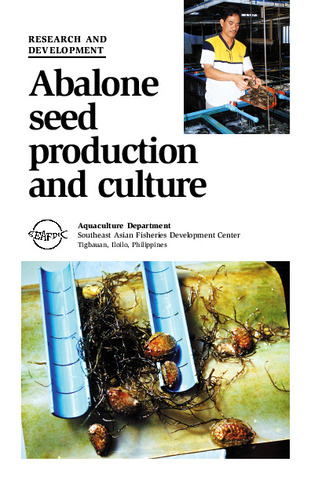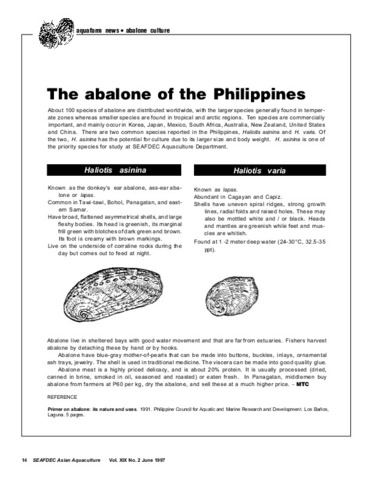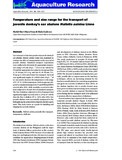Shell marking by artificial feeding of the tropical abalone Haliotis asinina Linne juveniles for sea ranching and stock enhancement
| dc.contributor.author | Gallardo, Wenresti G. | |
| dc.contributor.author | Bautista-Teruel, Myrna N. | |
| dc.contributor.author | Fermin, Armando C. | |
| dc.contributor.author | Marte, Clarissa L. | |
| dc.date.accessioned | 2014-03-26T08:56:08Z | |
| dc.date.available | 2014-03-26T08:56:08Z | |
| dc.date.issued | 2003 | |
| dc.identifier.citation | Gallardo, W. G., Bautista-Teruel, M. N., Fermin, A. C., & Marte, C. L. (2003). Shell marking by artificial feeding of the tropical abalone Haliotis asinina Linne juveniles for sea ranching and stock enhancement. Aquaculture Research, 34(10), 839-842. | en |
| dc.identifier.issn | 1355-557X | |
| dc.identifier.uri | http://hdl.handle.net/10862/1964 | |
| dc.description.abstract | A method of marking abalone (Haliotis asinina Linne) for sea ranching and stock enhancement purposes was developed. Three-month-old abalone juveniles (11.8-mm shell length, 0.28 g) were fed artificial diets for 1, 2, or 3 weeks. The width of the bluish-green shell band produced by abalone juveniles was 1.7, 2.6, and 4.2 mm after 1, 2, or 3 weeks of feeding respectively. The growth and survival of juveniles fed artificial diets did not differ from that of juveniles fed the seaweed Gracilariopsis bailinae (control). Feeding the diet-fed juveniles with the seaweed thereafter produced the natural brownish shell, thus forming a sandwiched bluish-green band. An experimental release in outdoor tanks with natural growth of seaweeds and diatoms, and in a marine reserve showed that the shell band remained clear and distinct, indicating the usefulness of this shell marking method in sea ranching and stock enhancement of abalone. | en |
| dc.language.iso | en | en |
| dc.publisher | Blackwell Publishing | en |
| dc.subject | Haliotis asinina | en |
| dc.subject | abalones | en |
| dc.title | Shell marking by artificial feeding of the tropical abalone Haliotis asinina Linne juveniles for sea ranching and stock enhancement | en |
| dc.type | Article | en |
| dc.identifier.doi | 10.1046/j.1365-2109.2003.00890.x | |
| dc.citation.volume | 34 | |
| dc.citation.issue | 10 | |
| dc.citation.spage | 839 | |
| dc.citation.epage | 842 | |
| dc.citation.journalTitle | Aquaculture Research | en |
| seafdecaqd.library.callnumber | VF SJ 0758 | |
| seafdecaqd.databank.controlnumber | 2003-26 | |
| dc.subject.asfa | aquaculture techniques | en |
| dc.subject.asfa | colour | en |
| dc.subject.asfa | diet | en |
| dc.subject.asfa | marking | en |
| dc.subject.asfa | ranching | en |
| dc.subject.asfa | shells | en |
| dc.subject.asfa | stocking (organisms) | en |
| dc.subject.asfa | feeding | en |
| dc.subject.asfa | abalone culture | en |
| dc.subject.asfa | aquaculture | en |
| dc.identifier.essn | 1365-2109 | |
| dc.subject.scientificName | Gracilariopsis heteroclada | en |
| dc.subject.scientificName | Haliotis asinina | en |
Files in this item
| Files | Size | Format | View |
|---|---|---|---|
|
There are no files associated with this item. |
|||
This item appears in the following Collection(s)
-
Journal Articles [1256]
These papers were contributed by Department staff to various national and international journals.



